Physical Address
304 North Cardinal St.
Dorchester Center, MA 02124
On completion of this chapter, you should be able to:
Understand the embryologic development of the fetal heart
Describe fetal circulation
List the maternal risks factors that would require fetal echocardiography
Explain how to sonographically evaluate the fetal heart with two-dimensional, M-mode, pulsed Doppler, and color flow Doppler imaging
Locate fetal ultrasound landmarks
Describe normal anatomy seen in the views discussed in this chapter
The continued development and improvement of high-resolution, real-time sonography has enabled the sonographer to visualize fetal cardiac activity with transvaginal transducers early in the first trimester. Although the detailed visualization of all the anatomic structures of the fetal heart is best imaged in the second and third trimesters. This ability to visualize cardiac anatomy has aided in the prenatal diagnosis of congenital heart disease. The incidence of congenital heart disease is about 8%, or 30,000 infants per year in the United States. Sonographic visualization allows the sonographer and clinician to image the small cardiac structures and obtain hemodynamic information from the fetal heart.
Conditions such as small cardiac defects, abnormal size or location of cardiac structures, arrhythmias, or abnormal cardiac function may all be observed with fetal echocardiography. The information obtained from the sonogram regarding the congenital heart defect is then managed through a team effort of multiple clinicians—including the pediatric cardiologist, obstetrician, perinatologist, geneticist, cardiovascular surgeon, and imaging specialists—to allow the patient to make educated decisions regarding the opportunities and outcomes for her fetus with a congenital heart defect.
Improvement in high-resolution transducers has permitted good resolution and visualization of even the smallest structures within the fetal cardiac chambers. These transducers and dedicated cardiac instrumentation, complete with motion mode (M-mode), 2D, 3D, 4D, color and Doppler capabilities, enable the sonographer to perform a complete fetal echocardiogram on obstetric patients between their 16th week of pregnancy and the time of delivery. Although fetal heart motion may be seen within the gestational sac as early as 4 to 5 weeks, structural information may be seen with the transvaginal probe as early as 10 to 16 weeks of gestation, with even more detailed information available after 18 weeks of gestation. The optimum time to perform a complete anatomical fetal echocardiogram is 18 to 22 weeks.
Fetal echocardiography has been a tremendous clinical aid for the high-risk obstetric patient. The ability to map normal cardiac structures and ventricular function in a patient who has had a previous child with congenital heart disease helps relieve the pregnant patient of worry. Moreover, if a congenital heart condition is found, arrangements may be made to deliver the patient in a facility with the appropriate staff to manage such a neonate.
The addition of Doppler and color flow imaging has aided the diagnosis of congenital heart disease and has helped in the understanding of flow dynamics in the fetus. These two modalities, Doppler and color flow imaging, are used with discretion in the fetus with congenital heart disease. Three-and four-dimensional echocardiography has been introduced in fetal echocardiography to allow more intricate visualization of the cardiac structures. This technique still requires a good axis of the fetal heart to be obtained before adequate interpolation of the data is made.
A single major error in the genetic constitution is the basis of congenital malformations. Human teratogens produce or raise the incidence of congenital malformations; 7% are caused by environmental agents or teratogens. A spontaneous abortion usually occurs if the genetic malformation is severe.
The most sensitive period in the first trimester for cardiac development is between 3.5 and 6.5 weeks. The cardiovascular system is the first organ system to reach a functional state; by the end of the third week, circulation of blood has begun.
The primitive heart is a tubular structure that forms like a large blood vessel from the mesenchymal cells in the cardiogenic area of the embryo. Paired endocardial heart tubes develop before the end of the third week and begin to fuse, thus forming the primitive heart.
The circulation of blood starts by the end of the third week as the tubular heart begins to beat. ( Fig. 35.1 ). The embryo obtains sufficient nourishment during the second week of development by diffusion of nutrients from maternal blood flow. The vascular system begins during the third week in the wall of the yolk sac, the connecting stalk, and the chorion. The blood vessels begin to develop 2 days later. Blood islands are formed; cavities develop in the islands to form primitive blood cells and vessels. These primitive vessels form a vascular network in the wall of the yolk sac. Blood vessels form in the mesenchyme associated with the connecting stalk and chorion. Blood vessels also form in the embryo toward the end of the third week and join to form a continuous system of vessels on each side.
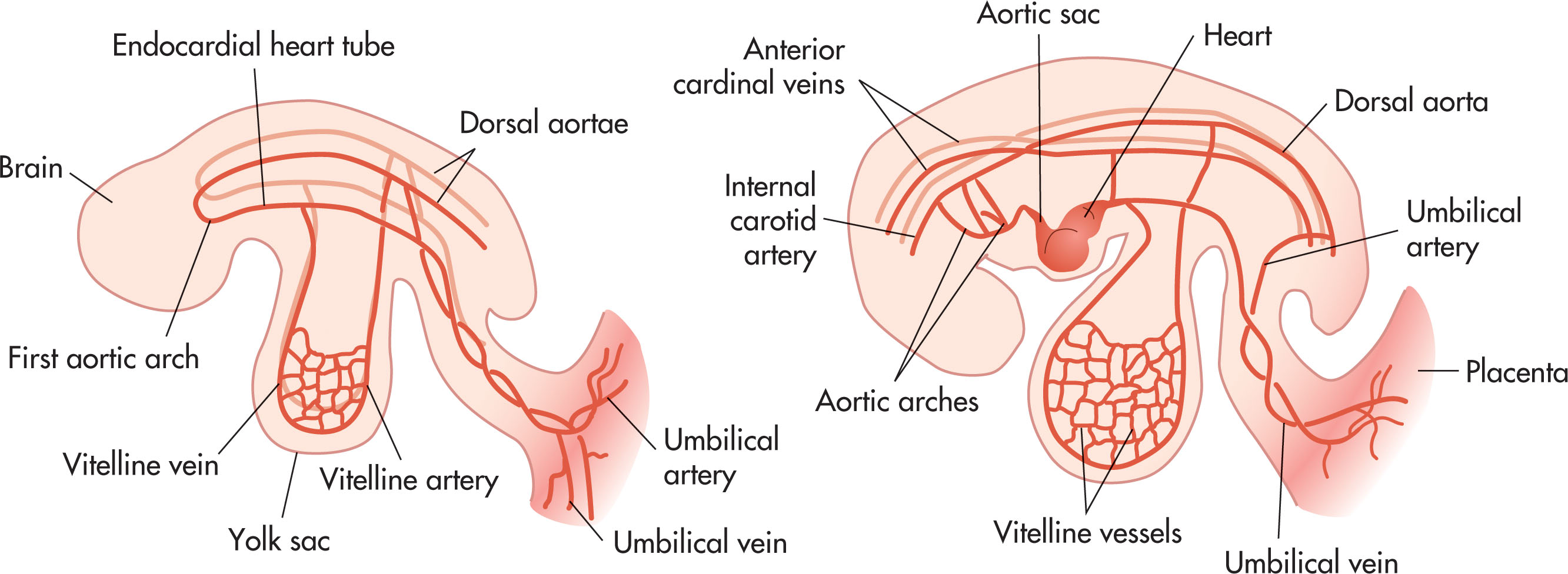
Blood vessels from the embryo join those on the yolk sac, connecting stalk, and chorion to form a primitive cardiovascular system (see Fig. 35.1 ). The cardinal veins return blood from the embryo, and the vitelline veins return blood from the yolk sac. The umbilical veins return oxygenated blood from the placenta (only one umbilical vein persists). Two dorsal aortas fuse in the caudal half of the embryo to form a single dorsal aorta. Blood formation in the embryo begins at the fifth week.
Each branchial arch is supplied by an aortic arch ( Fig. 35.2 ). The arteries to the fifth pair are rudimentary or absent. The third pair of aortic arches becomes the common carotid artery and the proximal parts of the internal carotid arteries. The left fourth arch forms part of the arch of the aorta. The right fourth arch forms the proximal part of the right subclavian artery. The right sixth aortic arch becomes the right pulmonary artery. The left sixth aortic arch forms the left pulmonary artery and the ductus arteriosus ( Box 35.1 ).
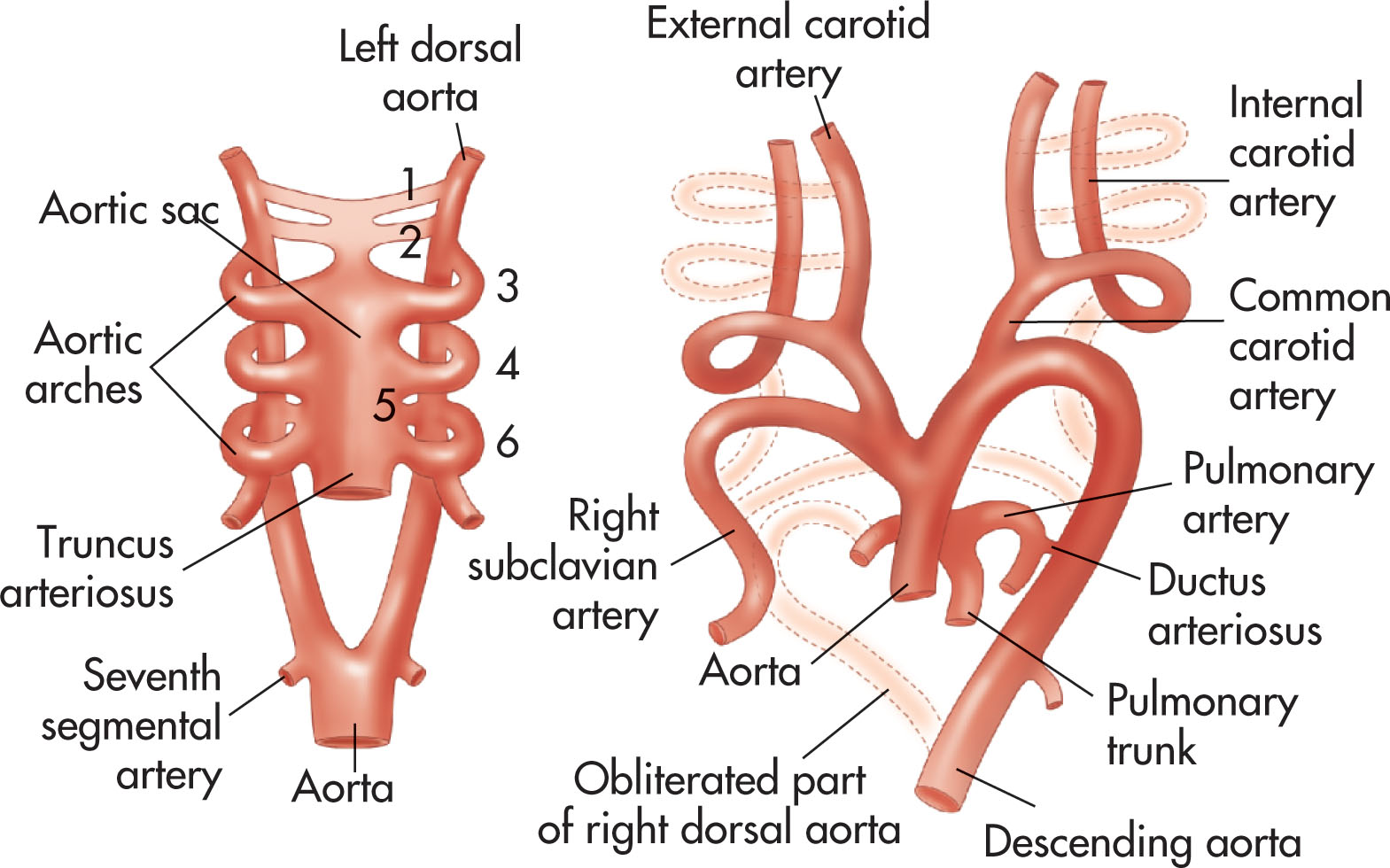
Sinus venosus: the caudal region of the primitive heart, which receives all blood returning to the heart from common cardinal veins, vitelline veins, and umbilical veins
Primitive atrium: develops into the right and left atria
Primitive ventricle: develops into the left ventricle
Bulbus cordis: develops into the right ventricle
Truncus arteriosus: dilates to form the aortic sac from which the aortic arches arise
The heart tube grows rapidly, bending on itself because it is fixed at its cranial and caudal ends. The bending forms a U-shaped bulboventricular loop. The sinus venosus is initially a separate chamber that opens into the right atrium ( Fig. 35.3 ).
Right atrium . The left horn of the sinus becomes the coronary sinus. The right horn is incorporated into the wall of the right atrium (forms a smooth portion of the adult right atrial wall). The right half of the primitive atrium persists as the right auricle.
Left atrium . The left atrium is formed by incorporation of the primitive pulmonary vein. As the atrium grows, parts of this vein and its branches are absorbed. Four pulmonary veins eventually enter the left atrium from the lungs. The smooth wall of the left atrium is from the absorbed pulmonary vein. The left auricle is from the primitive heart.
Four-chambered heart . During the fourth and fifth weeks of fetal development, the division of the four chambers occurs ( Fig. 34.4 ).
Division of the atrioventricular canal . Endocardial cushions develop in the atrioventricular region of the heart. The cushions grow toward each other and fuse to divide the atrioventricular canal into right and left canals.
Division of the primitive atrium . The septum primum grows from the dorsal wall of the primitive atrium and fuses with the endocardial cushions (see Fig. 35.4A–B ). Before the fusion of the septum primum, a communication exists between the right and left halves of the primum atrium through the ostium primum or foramen primum. As the septum primum fuses with the endocardial cushions (obliterating the foramen primum), the superior part of the septum primum breaks down, creating an opening called the foramen secundum (see Fig. 35.4A–B ). As this foramen develops, another membranous fold, the septum secundum , grows into the atrium to the right of the septum primum. The septum secundum overlaps the foramen secundum and the opening of the septum primum. There is also an opening between the free edge of the septum secundum and the dorsal wall of the atrium called the foramen ovale (see Fig. 35.4C ).
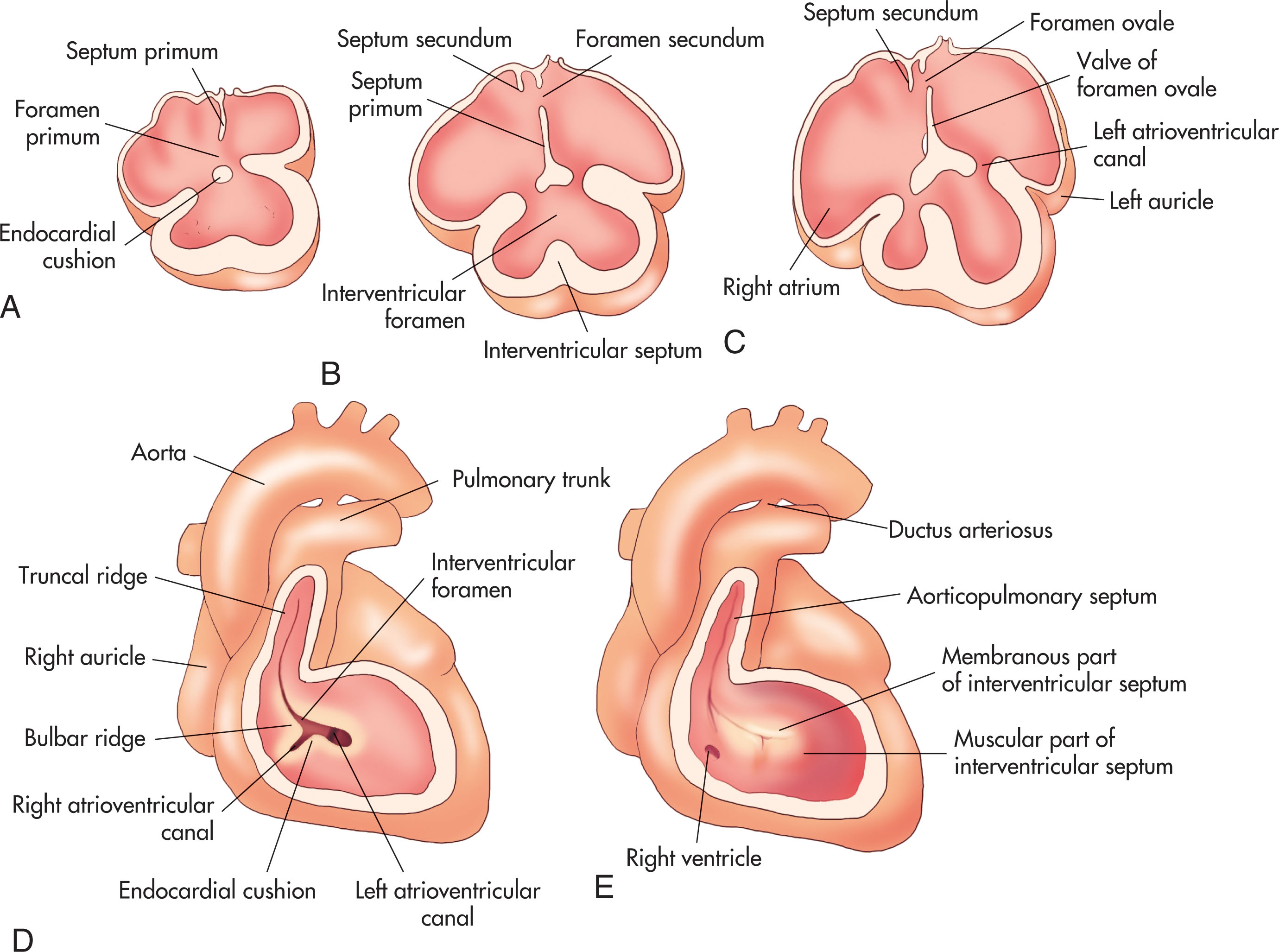
Formation of the ventricles . The left ventricle is formed from the primitive vein. The right ventricle is formed from the bulbus cordis . The interventricular septum begins as a ridge in the floor of the primitive ventricle and slowly grows toward the endocardial cushions (see Fig. 35.4B–C ). Until the seventh week, the right and left ventricles communicate through a large interventricular foramen. Closure of the interventricular foramen results in the formation of the membranous part of the interventricular septum.
Partitioning of bulbus cordis and truncus arteriosus . The division of this part of the heart results from the development and fusions of the truncal ridges and bulbar ridges (see Fig. 35.4D and E ). Fused mesenchymal ridges form the aorticopulmonary septum, which divides the truncus arteriosus and bulbus cordis into the ascending aorta (AA) and pulmonary trunk.
Development of the conduction system . The sinoatrial node forms in the wall of the sinus venosus near its opening into the right atrium; later it is incorporated into the right atrium with the right horn of the sinus venosus. The atrioventricular node and bundle are derived from cells in the walls of the sinus venosus and atrioventricular canal.
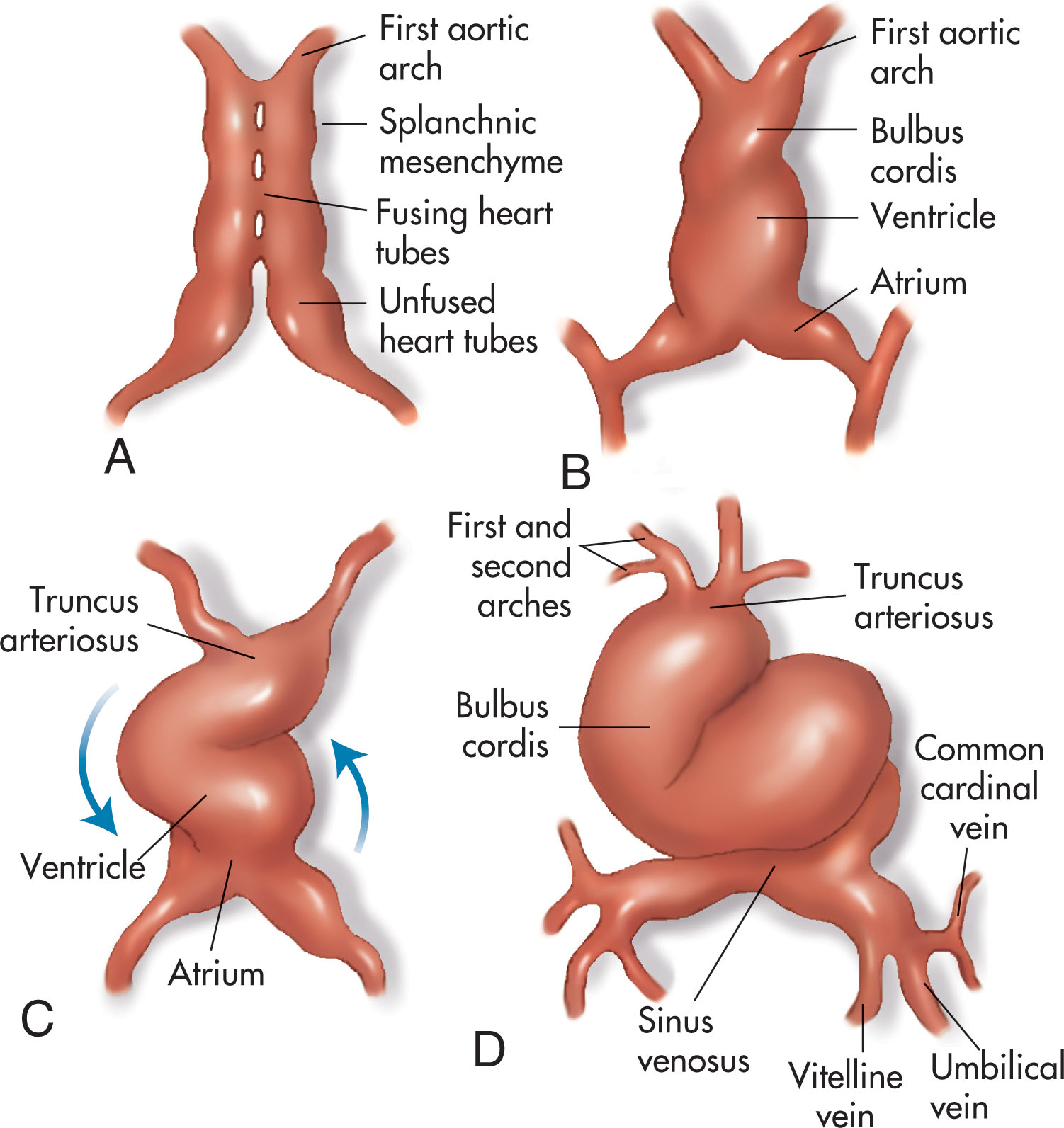
Blood flow in the fetus varies in two respects from the neonatal stage. Communication is open between the right and left sides of the fetal heart through the fossa ovale and between the aorta and the pulmonary artery via the ductus arteriosus . It is useful to know these important communications to appreciate the fetal physiology of the cardiac structures.
The primitive cardiovascular system is formed from the blood vessels in the embryo joining those on the yolk sac, connecting stalk, and chorion. The cardinal veins return blood from the embryo; vitelline veins return blood from the yolk sac; and umbilical veins return oxygenated blood from the placenta. Only one umbilical vein persists. Initially, there are two dorsal arteries, but these fuse together in the caudal half of the embryo to form a single dorsal aorta.
Before birth, the oxygenated blood is given to the fetus by way of the umbilical vein from the placenta to the heart. The design of the prenatal circulation is to ensure that the highly oxygenated blood from the umbilical vein quickly and efficiently flows into the heart. Approximately half of the blood passes through the hepatic sinusoids, whereas the remainder bypasses the liver to go through the ductus venosus into the inferior vena cava. Blood flows from the inferior vena cava and superior vena cava and enters into the right atrium ( Fig. 35.5 ). Blood in the right atrium is less oxygenated than blood in the umbilical vein.
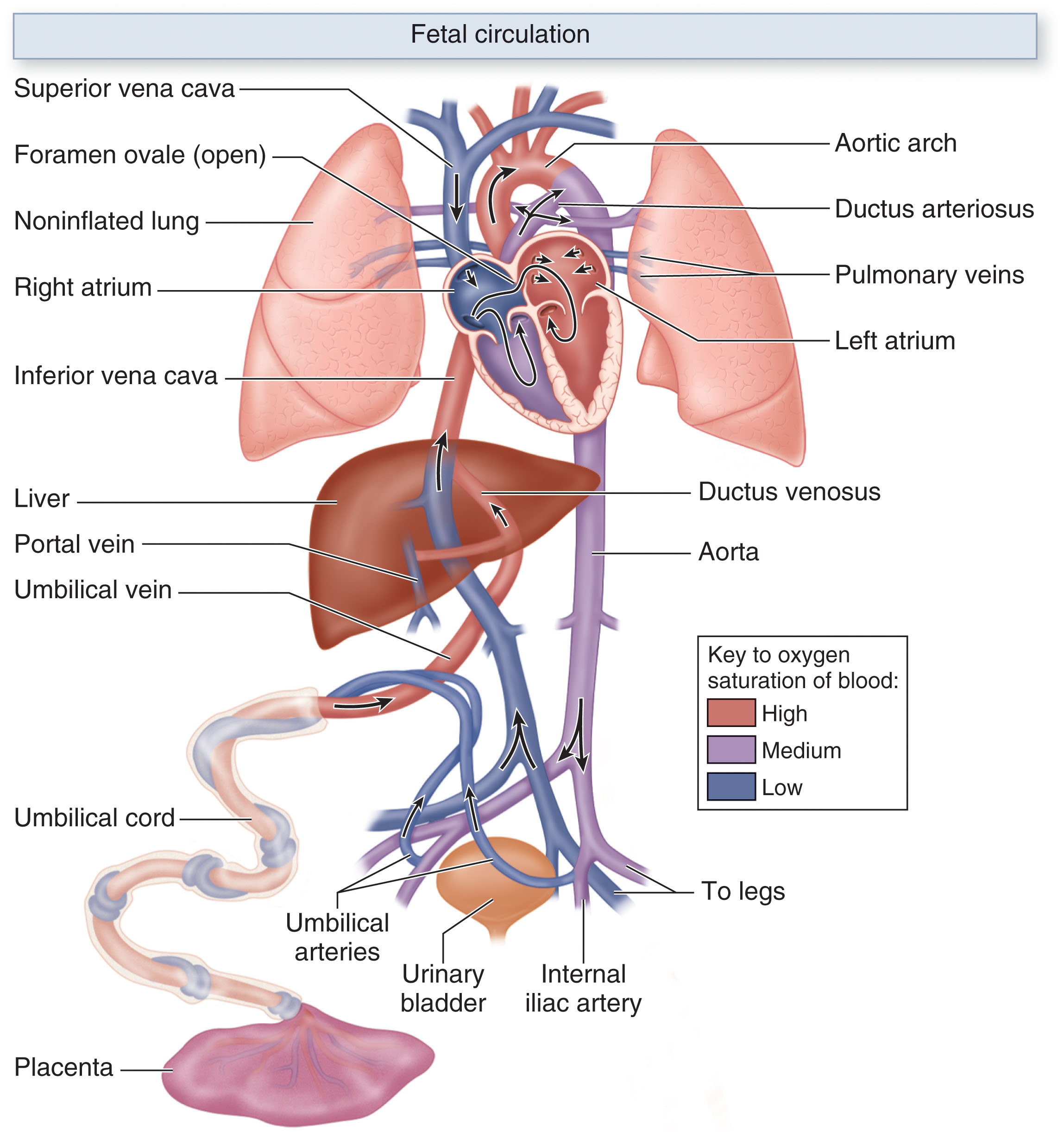
A small amount of oxygenated blood from the inferior vena cava is diverted by the crista dividens and remains in the right atrium to mix with deoxygenated blood from the superior vena cava and coronary sinus. The eustachian valve at the junction of the inferior vena cava and right atrium serves to direct the highly oxygenated umbilical venous flow toward the foramen ovale into the left atrium. Some of the blood from the inferior vena cava is directed by the lower border of the septum secundum (the crista dividens) through the foramen ovale into the left atrium.
The blood in the right atrium flows through the three-leaflet tricuspid valve into the right ventricle and leaves the right ventricle through the main pulmonary artery (MPA). This artery bifurcates into right and left pulmonary artery branches that lead to their respective lungs. However, most of this blood passes through the connection of the ductus arteriosus into the descending aorta; only a very small amount goes to the lungs.
The blood mixes with a small amount of deoxygenated blood as it returns from the lungs via the four pulmonary veins into the left atrium. The pulmonary veins enter the posterior of the left atrium. The four veins are named according to their locations: right upper, left upper, right lower, and left lower. The blood then flows from the left atrium into the left ventricle through the two-leaflet mitral valve and leaves the heart through the AA. The head, neck, and upper torso of the fetus are fed via the three branches arising from the aortic arch. These branches are the innominate, left carotid, and left subclavian arteries. The rest of the mixed blood in the descending aorta passes into the umbilical arteries and is returned to the placenta for reoxygenation. The remainder of the blood circulates through the lower part of the body.
At birth, the circulation of the fetal blood through the placenta ceases, the neonatal lungs begin to expand, and the blood flow to the lungs increases rapidly. The lungs are now able to provide oxygen and carbon dioxide exchange after the placenta has separated from the newborn infant. This expansion of the lungs causes several changes in the newborn. The fetal cardiac structures no longer necessary are the foramen ovale, ductus arteriosus, ductus venosus, and umbilical vessels ( Fig. 35.6 ).
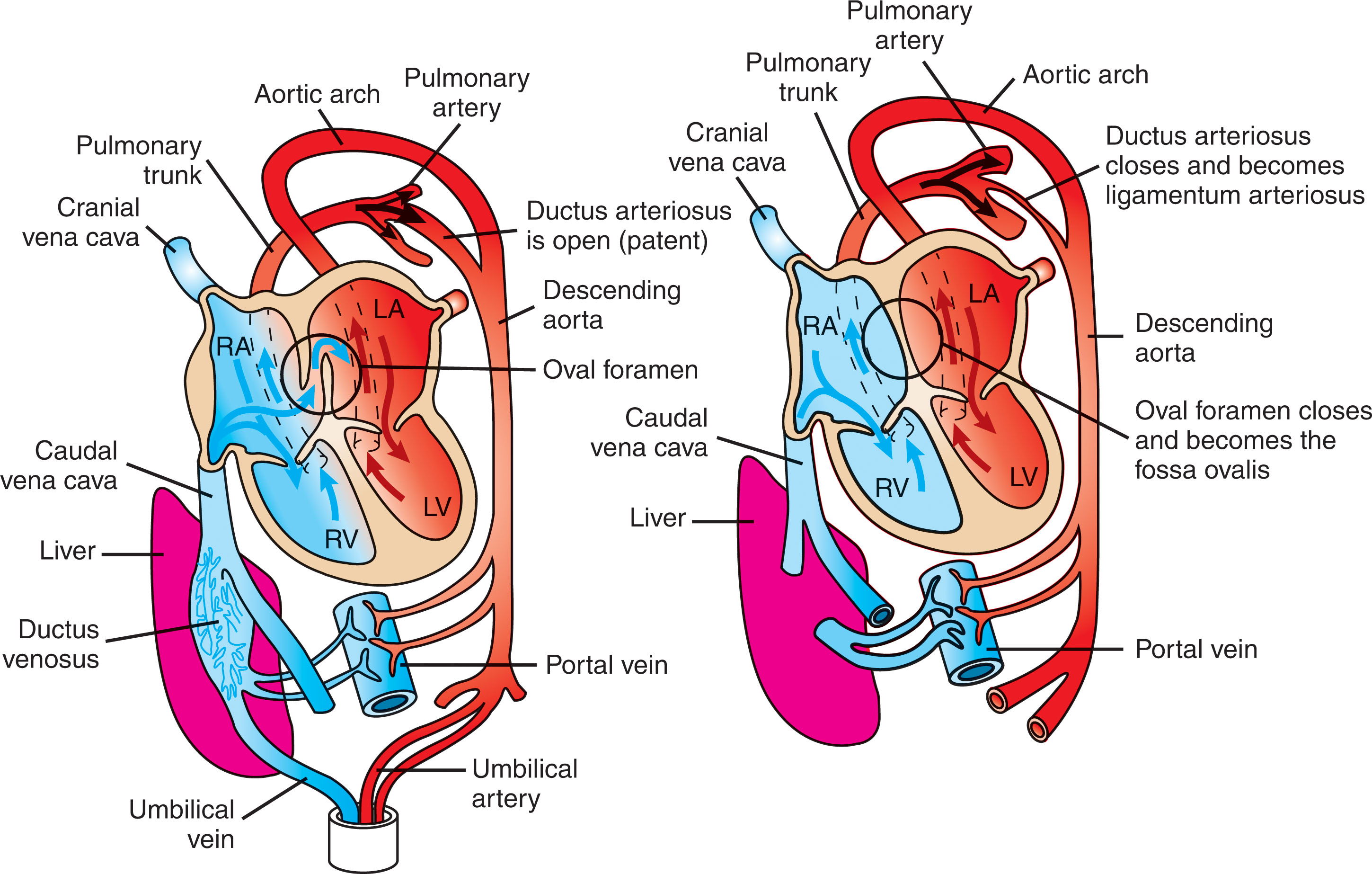
Omission of the placental circulation causes an immediate fall of blood pressure in the newborn’s inferior vena cava and right atrium. As the lungs expand with air, there is a fall in the pulmonary vascular resistance. This causes an increase in pulmonary blood flow and a progressive thinning of the walls of the pulmonary arteries. Thus, the pressure in the left atrium becomes higher than that in the right atrium. This causes the foramen ovale to close. With time, complete closure of the foramen occurs from adhesion of the septum primum to the left margin of the septum secundum. The septum primum forms the floor of the fossa ovalis. The lower edge of the septum secundum forms the limbus fossae ovalis, which demarcates the former cranial boundary of the foramen ovale. If this foramen ovale does not close after birth, it is known as a patent foramen ovale.
The ductus arteriosus usually constricts shortly after birth (usually within 24 to 48 hours) once the left-sided pressures exceed the right-sided pressures. Often there is a small shunt of blood from the aorta to the pulmonary artery until these pressures adjust to neonatal life. Once the ductus closes, it is known as the ligamentum arteriosum in the neonate. If this communication persists, it is called a patent ductus arteriosus . This ligament passes from the left pulmonary artery to the arch of the aorta. The persistence of the ductus arteriosus may eventually cause an overload on the left heart; thus the goal is to close the patent ductus either medically or surgically.
The umbilical arteries also constrict after birth to prevent blood loss from the neonate. The umbilical vein may remain patent for some time after birth.
The normal fetal heart rate is between 120 and 160 beats/min. In the first trimester of pregnancy, the heart rate begins around 90 beats/min and increases to 170 beats/min before returning to a normal rate and sinus rhythm. If the heart rate is too slow (less than 100 beats/min), it is called bradycardia ; a heart rate more than 200 beats/min is termed tachycardia .
A slow fetal heart rate places the fetus at higher risk of associated heart disease; fetal echocardiography should be performed to rule out the presence of a structural heart defect. The association of complete heart block with structural cardiac defects appears to have a poor prognosis, presumably because of the adverse interaction and the atrioventricular valve regurgitation that commonly complicates the condition. Connective tissue disorder (e.g., systemic lupus erythematosus) is associated with heart block and pericardial effusion.
Specific risk factors indicate that the fetus is at a higher than normal risk for congenital heart disease and warrants a fetal echocardiogram. These may be divided into the following three categories: fetal risk factors, maternal risk factors, and familial risk factors.
Become a Clinical Tree membership for Full access and enjoy Unlimited articles
If you are a member. Log in here